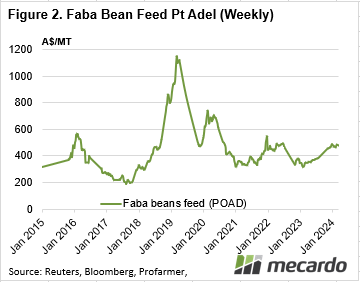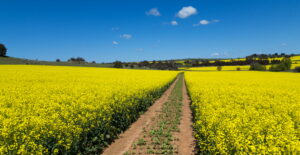Faba beans have become a popular break crop in southern states, delivering not only a valuable export or feed commodity, but also giving nutritional benefits to soils. The previous season saw lower plantings and yields, but a boost in prices.
Pulse
production, in general, has lifted in recent years, with increased plantings of
lentils and faba beans in recent years. Faba
bean production has been strong since 2020-21, as increased plantings coincided
with good seasons. Over 600,000 tonnes
of beans were produced in the three years before the current season. This year bean production fell below 500,000
tonnes but was still the fourth-highest level on record.
After
reaching record-high production in 2022-23, lentil production took a hit from the
drier year as well. This was despite
further increases in plantings.
Chickpea
production is expected to remain relatively steady this year. Plantings were down, and yields were expected
to be better.
In terms of
price, series are hard to come by. The
best one we have is faba beans at Port Adelaide. Figure 2 shows the rising trend of bean
prices over the course of 2023, and into 2024.
Bean prices have gained $150/t since last harvest, largely on the back
of export demand.
A 45%
increase in price is probably the best performance from a cropping commodity
this year when other grains have been in decline.
Chickpea
prices are also stronger this year and look to have been strengthening
lately. Last week’s quote for chickpeas
delivered in Brisbane was $880/t, up from $830/t back in March. Compared to last year chickpeas are up around
$300/t, or 54%.
Lentil
prices have shown a little less volatility, but are very close to chickpeas at $880-900/tonne
at southern ports. Again lentils are up
strongly on last year, having gained $200/t on the back of tighter supply.
What does it mean?
Certain price relativities will encourage shifts in winter crop plantings. The better pulse prices this year, and lower cereal and canola prices are likely to see some movement towards pulses if the seasons and rotations allow.
Ongoing prices depend on how rainfall pans out over the cropping season, but given how prices have moved this year, it would be a brave grower to hold on to pulses through the winter.
Have any questions or comments?
Key Points
- Pulse production was down this year, largely due to poorer yields.
- While major crop prices are down, pulse values have rallied on last year.
- Strong pulse prices will likely encourage higher planted hectares this season.
Click on figure to expand
Click on figure to expand
Data sources: Refinitiv, Mecardo














